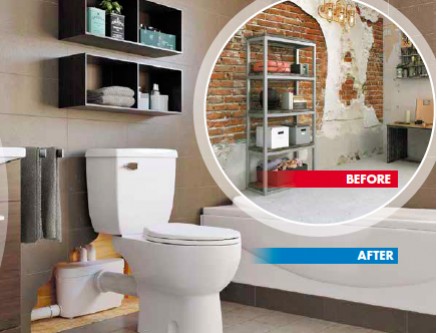Reasons Why You Shouldn't Consider Breaking the Concrete
Blog , Learn more , News 01/27/2021

RED FLAGS TO REMEMBER:
Cutting concrete undermines structural integrity: Any time you cut into a slab, you decrease the foundational integrity of the building — no matter how close to a perfect cut you make. You may be able to patch the hole you create well enough to eliminate any aesthetic objections. But is that floor as solid as it was before you began to cut? I would bet not — especially if you fail to use the same or a better grade of concrete. And if the home sits on ground that’s less than solid, such as sand, it may begin to settle differently after the cut. In a multi-floor building, cutting into a slab on the second, third, fourth levels to run plumbing beneath the floor would be a huge no-no. That’s why commercial renovation projects that require additional plumbing will typically use external soil stacks, putting the external plumbing tree on the outside of the building. Well, if you shouldn’t cut into any of the upper levels of a building, why would you think you could safely cut into the first level — the slab on which everything else sits?
- Cutting concrete is unpredictable: Installers don’t always know the depth of the concrete, whether it sits on rocks or a ledge, or whether it contains rebar or tension cables. You can cause major damage if you accidentally cut one of those cables. Professional contractors understand this hazard and never begin cutting without first using an x-ray machine to determine the positioning of the cables. But even then, the slab was most likely designed to use a certain number of cables with a certain amount of concrete. If you begin removing chunks of concrete, those tension wires may begin pulling in a different direction, creating integrity problems and causing delays and extra expense.
- Cutting concrete is seldom, if ever, perfect: I may try as hard as I can to cut a perfect circle, square or rectangle into a floor for burying a sewage ejector and its waste-storage basin — but no way. That “perfect” shape will inevitably crack on the edges and fray outward in unintended directions, often well beyond the hole I am digging. And once a stress crack is created, how far down does it extend into the footing or into the walls?
- Cutting concrete creates leaks and seepage: Once a stress crack is generated, radon and ground-water penetration is a major issue, with the latter bringing unwanted moisture and mold problems as well. You don’t need a major flood to trigger these hazards. A higher-than-usual water table because of extended wet weather, such as in the spring, could be the culprit. Even if the cracks and seepage are not large enough to jeopardize the foundation, enough wetness could infiltrate to ruin walls, floors and furnishings in a finished living area — including that beautiful new bathroom that necessitated digging through the concrete in the first place.
OTHER SERIOUS CONCERNS Of course, there are other negatives you should carefully consider:
- Dust, dust and more dust: Breaking through concrete generates an extraordinary amount of noise and dust. Happily, the noise stops when the jackhammers and saws shut down, and the workers finish their backbreaking job of hauling concrete chunks off the premises. But the dust doesn’t fade nearly so quickly. That’s because it is not conventional household dust, but a thick particulate that inevitably gets into everything, including the central air system, which means it can be around for a long time if not properly handled. I have heard of homeowners finding pockets of concrete dust years after a project finished. Obviously, this dust is not something you would want your family breathing for any length of time. (You might think the same for your own crews.) Anyone contemplating this type of work must seriously consider what sort of air-purification process is needed to remove all the dust from the premises.
- Cost factors: Last, but certainly not least, there’s the problem we mentioned at the outset of this article, the one that often proves to be the biggest deal-breaker of all: cost. The actual expense of cutting concrete depends on the size and complexity of the job, as well as local labor availability and rates. In some parts of the nation, the per-foot rate may be a few hundred dollars; in others, $1,000 or more.
Seeing these costs, some plumbers outsource the work and are content to make little or no markup on their sub’s charges. Others, preferring to keep the job in house, absorb the time and cost of renting the cutting and hammering tools and lugging them on and off the job site; or, if they choose to buy, the cost of maintaining and replacing these tools, as well as depreciation.
